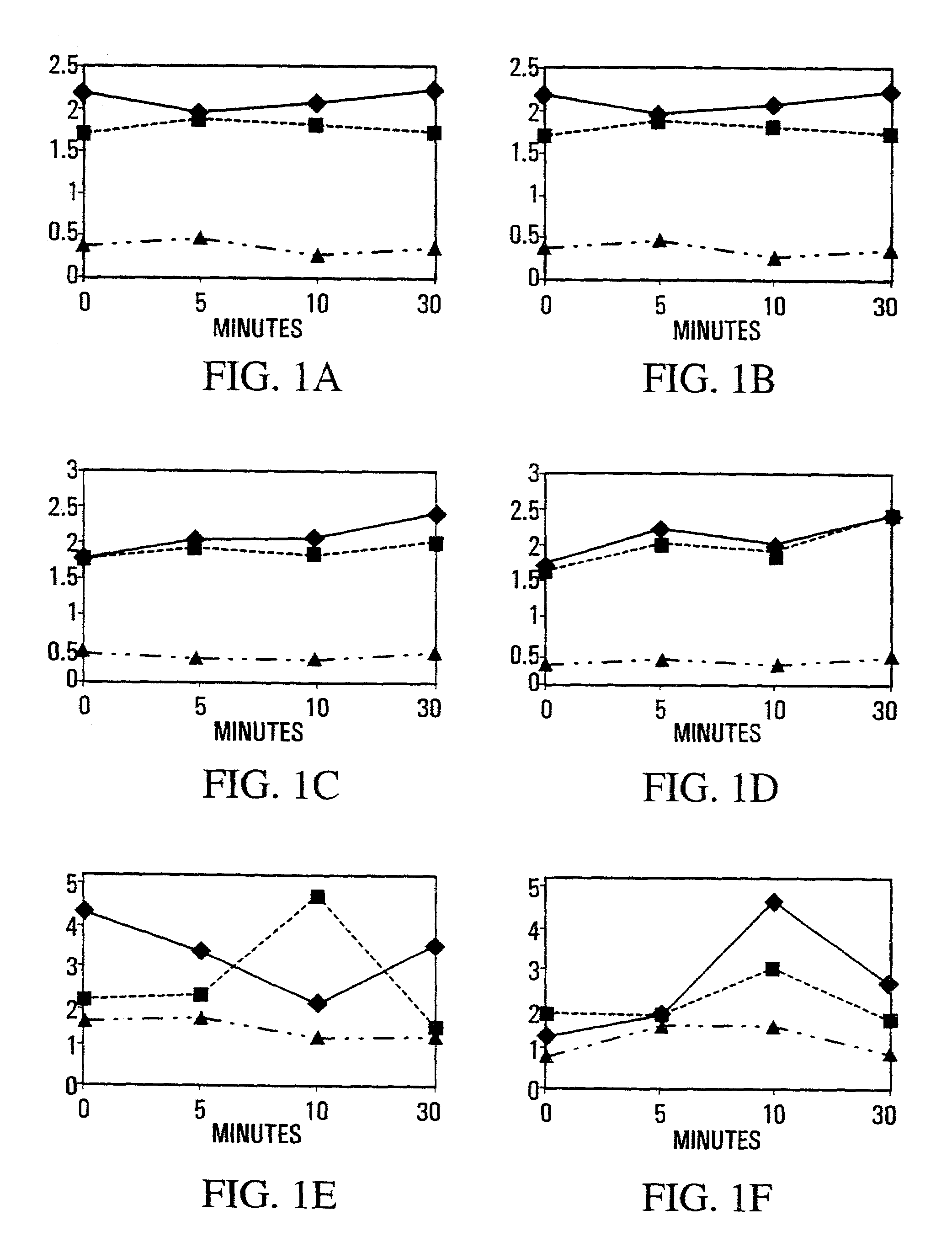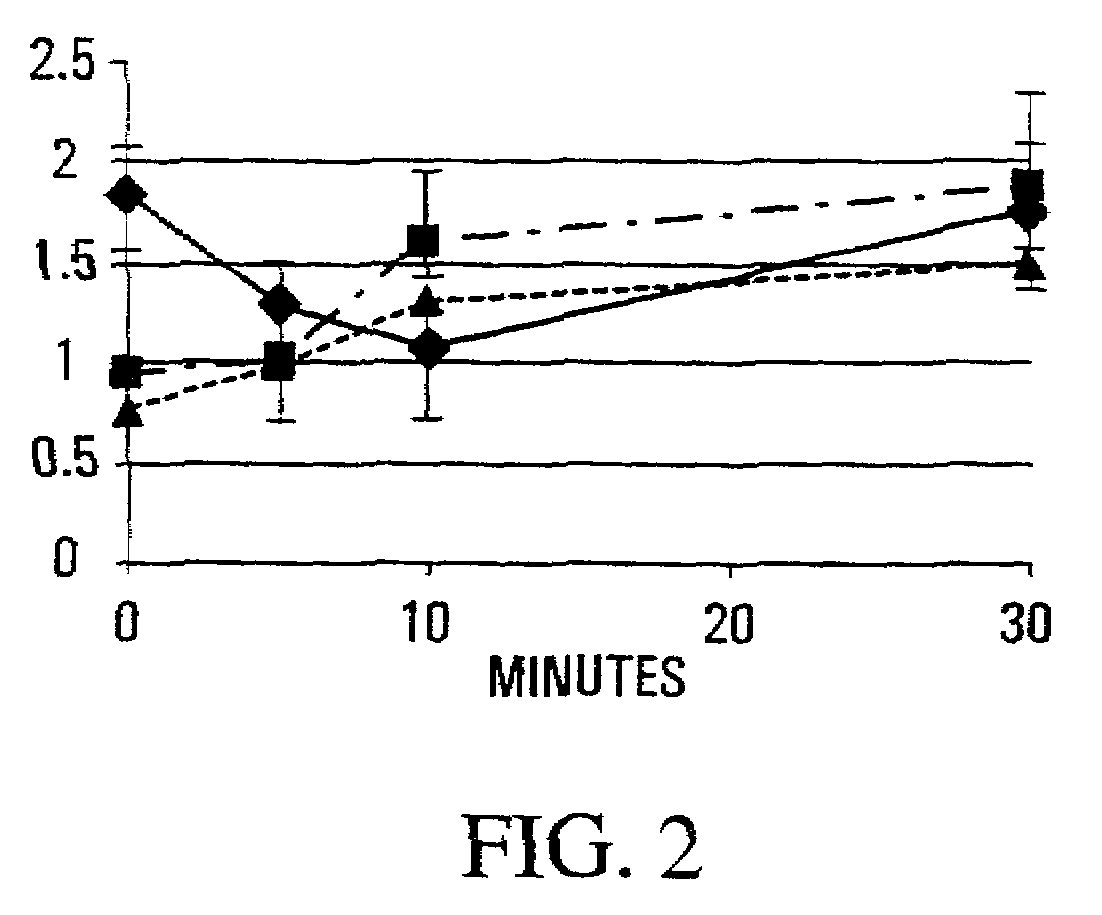Nitric oxide manipulation of muscle satellite cell activation
- Summary
- Abstract
- Description
- Claims
- Application Information
AI Technical Summary
Benefits of technology
Problems solved by technology
Method used
Image
Examples
example 1
Preliminary Procedures for Manipulating NO Level
[0178]Male normal mice (C57BL / 6 and B6, 129SF (Jackson Laboratories)), mdx mutant mice (C57BL / 10 ScSn, Central Animal Care Services, University of Manitoba) and NOS-I knockout mice (B6,129S-Nos1tm / plh, Jackson Laboratories), 6–8 weeks-of-age were treated double-blind, in order to guidelines of the Canadian Council on Animal Care (reference #R-99–003). Studies were designed to determine the effects of manipulating NOS activity on the number and myogenic nature of cells isolated from muscles with and without injury, and examine longer term effects of NOS inhibition.
[0179]NOS activity was influenced by an intra peritoneal (ip) injection (80–100 μl by Hamilton syringe) exactly 30 min. before crush to the right tibialis anterior (TA) muscle of mice rested at least a week after transport from the breeding facility. Mice were injected with saline or saline containing one of three drug treatments as follows: the NOS inhibitor Nω-nitro-L-argini...
example 2
Effects of NOS Manipulation in Normal Mice
[0189]The myogenic nature of cells isolated from muscles in the 0–30 min. time course was confirmed by counting the proportion of c-met+cells 12–24 hr. after plating. Myogenic cells formed the large majority of cells isolated from the normal LTA (83–94%) and RTA muscles (86–92t) (n=997 cells). After 24 hours in culture, cells were typically round or elongated, and 10–25% had nuclei that were intensely positive for BrdU incorporation. After 4–5 days in culture, dark c-met staining was present in single cells and in small multinucleated myotubes. Cultured cells from different treatments, recovery times and muscles were identical in appearance despite differences in cell yield (see below).
[0190]Muscle weight as a proportion of body weight (FIGS. 1A–D) was used to monitor edema secondary to tissue damage. The weight of muscles dissected from saline-treated normal mice showed a 10–15% increase in RTA over LTA that began immediately after injury. ...
example 3
Effects of NOS Inhibition in MDX Dystrophic Muscle Vs. NOS-I Knockout in Muscle
[0195]Since satellite cells are intimately contoured to fibers and often stay attached to the external lamina as the sarcolemma buckles after injury (Schultz and McCormick, 1994 Rev. Physiol. Biochem. Pharmacol. 123, 213–257), they are ideally positioned to be “first responders” to a shear-induced release of NO from the subjacent NOS-Iμ. As activation would increase the harvest of myogenic cells from a single muscle by reducing their adhesion to fibers and lamina, and would also affect subsequent muscle repair, the release of myogenic cells from single crush-injured muscles was used as an index of the collective process in muscle. Experiments were carried out in normal mice pretreated to inhibit or augment NOS activity, and one tibialis anterior (TA) muscle was crush-injured 30 min. later. Cell yields from injured and undamaged muscles were determined over 30 min. immediately after crush, and longer term ...
PUM
 Login to View More
Login to View More Abstract
Description
Claims
Application Information
 Login to View More
Login to View More - R&D
- Intellectual Property
- Life Sciences
- Materials
- Tech Scout
- Unparalleled Data Quality
- Higher Quality Content
- 60% Fewer Hallucinations
Browse by: Latest US Patents, China's latest patents, Technical Efficacy Thesaurus, Application Domain, Technology Topic, Popular Technical Reports.
© 2025 PatSnap. All rights reserved.Legal|Privacy policy|Modern Slavery Act Transparency Statement|Sitemap|About US| Contact US: help@patsnap.com



